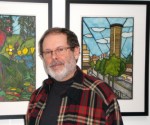Dr. Carl Rothschild has always had artistic inclinations but he could never choose one creative medium over the others. In the end, like a Renaissance man, he chose them all. He plays violin and viola. He’s made sculptures and wood carvings. He studied theatre. He has been writing poetry since high school, and painting and drawing even longer. He’s an artist through and through, unable to exist without making art in one form or another, even though his chosen profession is child psychiatry.
“I always drew pictures,” he said about his early years. “When I told my mom I wanted to be an artist, I was six at the time, she said: ‘Doctors paint.’ When I mentioned that I liked playing music, she replied: ‘There’re doctors’ orchestras.’”
She wanted him to be a doctor, and he followed her advice. He doesn’t regret his choice. “At least I’m not starving,” he said with a smile. But he continued his involvement with the arts as a hobby, albeit a serious one. His first solo show of paintings, Stained Glass in Watercolor, opened on March 20 at the Sidney and Gertrude Zack Gallery.
Every painting in the show resembles a stained-glass panel; every shape is delineated by a dark outline. Inside the outlines, color rules. Yellow torches of the autumn trees stand along a street like soldiers on parade. Red tulips glow like candles above the grey flagstones of a backyard. Bluish sky melts into the pearly sea at the horizon, while the dramatic black borders cut across nature’s immensity, bringing it closer to humans and to the boulders on the beach.
Stained-glass technique is Rothschild’s latest creative mode. He is exploring its possibilities and shares his discoveries with viewers. “When our eye looks at two objects side by side,” he explained, “it sees a black separation line between them. When I insert the black lines myself, I can contain the shapes. I have control over them, and each object is discrete. I place them wherever I want in the picture.”
His images are never photographic. Whether the inspiration for a painting comes from a photo or a scene he has witnessed, or from his own poems, the end result is invariably his impressions of the objects that attracted his interest. “I saw those red trees and I wanted to paint them. I placed them in the painting, but they couldn’t be alone, they needed a street, a house, so I painted them, too.”
Besides shapes and lines, the stained-glass technique also fascinates Rothschild because of the texture and color variations in every glass fragment, he said. He tries to replicate the effect in his paintings, so his colors are muted, fluctuating inside the shapes he has imposed. “I like rounded lines; they’re easier on the eye,” he admitted. “It’s like the lines are dancing.”
His creative process implies a deep knowledge of the subject, but he is mostly self-taught. “I only started taking regular art lessons three years ago,” he said. “I was unsure whether I should continue painting. I visited a friend and talked to him about it. He had some watercolors by Susan Pearson on his walls. I liked them, and he said he knows the artist, why don’t I talk to her. So I did. I took my sketchbooks to this [artist] and I said I wanted to know where I was in my art. Am I an artist? Should I continue? She said: ‘Yes, of course, you’re an artist.’ Since then, I’ve been taking lessons with her every week.”
Those lessons contributed to another of his recent creative endeavors: in 2013, he published a book of drawings and poems, Almost Missed, on sale alongside his paintings at the gallery. “Only one painting in the book is done in the stained-glass technique, the first one I ever tried,” he said. “It was for my poem ‘In Memory of My Father’s Death.’ I liked it and started painting other pictures the same way.”
Most other illustrations in the book originated from one or another of Pearson’s lessons. They are either classic watercolor landscapes, airy and light, almost transparent, still-life pictures and abstracts based on the ideas and images of still life.
The connections between the poetry and pictures are intimate and allusive, and are woven together throughout the book. “Art is a synthetic process,” he said. “It comes out in whatever you do: poetry, visual art, furniture making. I always made art. Once, my family moved into a new home, and the previous owners left a stack of wooden kitchen cabinet doors in the basement. I started carving those doors. I don’t know what happened to them when we moved again. I also tried sculpture. When I was at university, my friend needed help in making dental samples. I helped him, and then used the same material for small sculptures. I also made a chess set for a friend.”
The modest Rothschild said he regards his constant creative output as relatively insignificant, but his sensitivity and artistry is unmistakable. Despite a medical degree and a psychiatric practice, in his heart, Rothschild is definitely an artist.
Stained Glass in Watercolor is on exhibit at Zack Gallery until April 27.
Olga Livshin is a Vancouver freelance writer. She can be reached at olgagodim@gmail.com.

